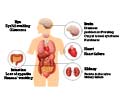Higher the amyloid amounts higher the decline in the area of cognition. The symptoms related to amyloid can be detected as early as middle age.

‘Increased amyloid plaque leads to increased cognitive decline, and therefore an early intervention is needed to prevent the cognitive disorder.’





Amyloid plaques, a sticky buildup that gradually gathers outside of neurons and is a hallmark of Alzheimer's disease, are believed to start accumulating in the brain 10 to 20 years before the onset of dementia."We think it is critical to examine middle-aged adults to detect the earliest possible signs of Alzheimer's disease, because it is becoming increasingly clear that early intervention will be the key to eventually preventing Alzheimer's disease," said Michelle Farrell, a PhD student at the center and the lead author of the study."
The study presents some of the first data on amyloid and its cognitive consequences in adults ages 40 to 59. For these middle-age adults, the study found that higher amyloid amounts were associated with declines in vocabulary, an area of cognition that is generally preserved as people age.
The results suggest that a new approach might be needed to provide physicians and patients with information about the future for someone with amyloid deposits.
Amyloid PET scan results are typically presented as either positive or negative, but the new findings suggest that the amount of amyloid in the brain provides useful prognostic information about how rapidly cognition may decline in the future.
Advertisement
Park heads up the Dallas Lifespan Brain Study, which is a multi-year research project aimed at understanding what a healthy brain looks like and how it functions at every decade of life from age 20 through 90. Each of the nearly 500 volunteers in the study undergo tests every four years.
Advertisement
In the JAMA Neurology research, the three middle-age adults who had the highest amyloid amounts and greatest vocabulary decline were also found to have a double dose of the ApoE-4 gene implicated in Alzheimer's. This means they received a copy of the gene from each of their parents.
Only about 4 percent of the population carries this genetic combination, and the finding hints at the possibility that subtle symptoms of cognitive decline related to amyloid may be detectable as early as middle age in this vulnerable population.
Source-Eurekalert














